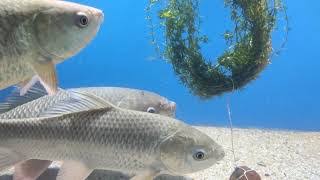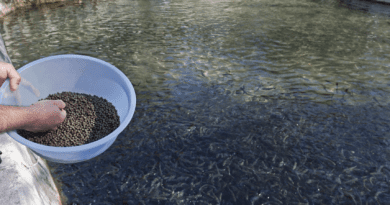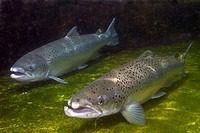How to Farm and Care for Rohu Fish (Labeo rohita)
Rohu scientifically known as Labeo rohita is a prominent freshwater fish species that holds significant importance in various parts of Asia, particularly in South Asian countries like India, Bangladesh, Nepal, and Pakistan.
Known for its delectable taste and nutritional value, the Rohu has become a staple in the diets of millions, contributing to both food security and economic sustainability in the region.
This resilient fish species is primarily found in rivers, lakes, and ponds, thriving in diverse aquatic environments. Its adaptability to different water conditions has contributed to its widespread distribution and popularity among aquaculturists. The Rohu is a member of the carp family (Cyprinidae) and is characterized by its sleek, silver-scaled body, slightly arched head, and distinctive reddish fins.
One of the key reasons behind the widespread cultivation of Rohu is its high protein content and essential nutrients. Rich in omega-3 fatty acids, vitamins, and minerals, Rohu offers a well-rounded nutritional profile. The fish is not only a source of protein but also provides essential nutrients like phosphorus, selenium, and vitamin D, promoting overall health and well-being.
Beyond its nutritional value, the Rohu plays a crucial role in the economies of the regions where it is cultivated. The aquaculture of Rohu has become a significant industry, providing livelihoods for many individuals involved in its farming, processing, and distribution. The fish has not only become a dietary staple but also a source of income and employment for numerous communities.
The versatility of Rohu is evident in its preparation in various culinary traditions. Whether grilled, fried, or prepared in curries, the fish adapts to diverse cooking methods, making it a favorite among chefs and home cooks alike. Its mild flavor and firm texture make it suitable for a wide range of culinary applications, from traditional dishes to modern, fusion cuisines.
In addition to its economic and culinary significance, Rohu holds cultural importance in the communities where it is consumed. Festivals, celebrations, and family gatherings often feature Rohu as a centerpiece, symbolizing abundance, prosperity, and communal harmony.
Despite its popularity, the cultivation of Rohu also faces challenges, including environmental changes, habitat degradation, and overfishing. Sustainable practices in aquaculture and conservation efforts are crucial to ensuring the long-term viability of Rohu populations and the preservation of the ecosystems they inhabit.
However, Rohu (Labeo rohita) stands as more than just a fish; it represents a nexus of nutrition, livelihoods, culture, and environmental stewardship. Its journey from water bodies to dinner plates underscores its multifaceted significance in the lives of those who depend on it, making it a truly remarkable and cherished species in the aquatic world.
Read Also: Goats Farming Complete Practical Guide
Selecting the Right Rohu Fish Species for Your Farm

Selecting the right Rohu (Labeo rohita) fish species for your farm is a crucial decision that requires careful consideration of various factors. Understanding the specific characteristics of the fish and its compatibility with your aquaculture environment is essential for a successful farming venture.
When choosing Rohu for your farm, it’s important to evaluate the regional variations in this species. Different populations may exhibit slight variations in growth rates, size, and adaptability to local environmental conditions. Consulting with local experts or fisheries authorities can provide valuable insights into the most suitable Rohu strain for your specific location.
Consideration of the water quality and temperature of your aquaculture facility is paramount. Rohu, being a freshwater species, thrives in well-oxygenated water with optimal temperature ranges. Ensuring that your farm’s water parameters align with the natural habitat of Rohu will contribute to healthier and more robust fish.
Furthermore, assess the nutritional requirements and feeding habits of the Rohu strain you plan to cultivate. Understanding the dietary preferences and nutritional needs of the fish will aid in formulating an appropriate feeding strategy. High-quality feed that meets the nutritional demands of Rohu at different life stages is essential for optimal growth and development.
Selecting disease-resistant Rohu strains is another vital aspect of successful aquaculture. Disease outbreaks can have detrimental effects on fish populations, leading to economic losses. Choosing genetically robust Rohu varieties that exhibit resilience to common diseases in your region can enhance the overall sustainability of your farming operation.
Consider the market demand and preferences when selecting Rohu species for cultivation. Understanding consumer preferences for size, taste, and appearance can guide your decision-making process, ensuring that your farm produces Rohu that aligns with market expectations.
In addition, the careful selection of the right Rohu (Labeo rohita) fish species for your farm involves a thoughtful analysis of regional variations, water conditions, nutritional requirements, disease resistance, and market demands. This holistic approach will contribute to the success and sustainability of your Rohu aquaculture venture.
Setting Up Your Rohu Fish Farm: A Step-by-Step Guide
Setting up your Rohu (Labeo rohita) fish farm requires a systematic approach to ensure a successful and sustainable aquaculture venture. Follow this step-by-step guide to establish and manage your Rohu fish farm effectively.
1. Site Selection: Choose a suitable location for your fish farm, considering factors such as water quality, temperature, and accessibility. Ensure that the site provides adequate space for pond construction and expansion.
2. Pond Construction: Build well-designed ponds with proper dimensions, water inlet, and outlet structures. Ensure that the pond layout allows for efficient water circulation and drainage. Adequate pond depth is crucial for maintaining favorable water conditions.
3. Water Quality Management: Regularly monitor and manage water quality parameters such as dissolved oxygen, pH, ammonia, and temperature. Implement practices to maintain optimal water quality, promoting the health and growth of Rohu.
4. Stocking Density: Determine the appropriate stocking density based on the size of the pond and water quality. Avoid overstocking, as it can lead to stress, disease, and poor growth rates. Follow recommended stocking guidelines for Rohu aquaculture.
5. Seed Selection: Choose high-quality Rohu fingerlings from reputable hatcheries. Consider factors like genetic traits, disease resistance, and regional adaptability when selecting the seed for stocking.
6. Feeding Management: Develop a feeding strategy that aligns with the nutritional requirements of Rohu at different growth stages. Use high-quality, nutritionally balanced feed to support optimal growth and development.
7. Disease Prevention and Management: Implement biosecurity measures to prevent the introduction of diseases to your farm. Regularly monitor fish health, and promptly address any signs of illness. Consult with aquaculture experts for disease management guidance.
8. Harvesting and Marketing: Plan the harvest timing based on the desired market size of Rohu. Use humane and efficient harvesting techniques. Establish a marketing strategy to sell the harvested fish, considering local demand and preferences.
9. Record Keeping: Maintain detailed records of pond management activities, stocking details, feeding regimes, water quality parameters, and health observations. Accurate record-keeping aids in decision-making and farm management.
10. Continuous Monitoring and Adaptation: Regularly monitor the performance of your Rohu fish farm. Adapt management practices based on the changing needs of the fish, environmental conditions, and market dynamics. Continuous improvement is key to long-term success.
By following this step-by-step guide, you can establish and manage a Rohu fish farm that is not only economically viable but also environmentally sustainable. Paying attention to key factors such as water quality, stocking practices, and disease management will contribute to the overall success of your Rohu aquaculture venture.
Nutrition Essentials: Feeding Your Rohu Fish for Optimal Growth
Feeding your Rohu (Labeo rohita) fish with a well-balanced and nutritious diet is paramount for achieving optimal growth and ensuring the overall health of your aquaculture venture. Understanding the nutritional requirements of Rohu at different life stages and tailoring the feeding regimen accordingly is crucial for maximizing productivity.
Rohu, like other fish species, requires a combination of macronutrients and micronutrients to support its growth, development, and physiological functions. Proteins are a fundamental component of the Rohu diet, serving as the building blocks for muscle development and overall body structure. High-quality protein sources, such as fish meal and soybean meal, are commonly used in commercial fish feeds to meet the protein needs of Rohu.
In addition to proteins, lipids (fats) play a significant role in providing energy for metabolic processes and supporting the absorption of fat-soluble vitamins. Including sources of essential fatty acids, such as fish oil, in the diet is crucial for promoting proper growth, reproduction, and immune function in Rohu.
Carbohydrates are another essential component of the Rohu diet, contributing to energy production. However, the carbohydrate content in the diet should be carefully balanced, as excessive levels can negatively impact water quality and fish health. High-quality carbohydrate sources, such as grains and cereals, are often incorporated into fish feeds to provide a well-rounded nutritional profile.
Vitamins and minerals are indispensable for various physiological functions, including bone development, immune response, and enzyme activity. A diverse and balanced mix of vitamins and minerals in the diet is essential to prevent deficiencies and promote overall fish well-being. Commercial fish feeds are formulated to include a spectrum of vitamins and minerals necessary for Rohu’s nutritional requirements.
Feeding strategies should be adapted to the different life stages of Rohu, from fingerlings to marketable size. In the early stages, providing highly digestible and nutrient-dense feeds supports rapid growth and development. As the fish mature, adjusting the feed composition to meet changing nutritional needs is essential for sustained growth and health.
Monitoring feeding rates and adjusting them based on environmental conditions, water temperature, and fish behavior is key to optimizing feed utilization. Overfeeding can lead to water quality issues and increased production costs, while underfeeding may result in stunted growth and reduced productivity.
It’s important for aquaculturists to stay informed about advancements in fish nutrition and feed technology. Research and innovation in feed formulations can offer opportunities to enhance the efficiency and sustainability of Rohu aquaculture.
In addition, feeding your Rohu fish for optimal growth involves a comprehensive understanding of their nutritional requirements, selecting high-quality feeds, and implementing feeding practices tailored to different life stages. A well-managed and nutritionally balanced diet is not only vital for the health and growth of Rohu but also contributes to the overall success and sustainability of your aquaculture enterprise.
Disease Prevention and Control in Rohu Fish Farming
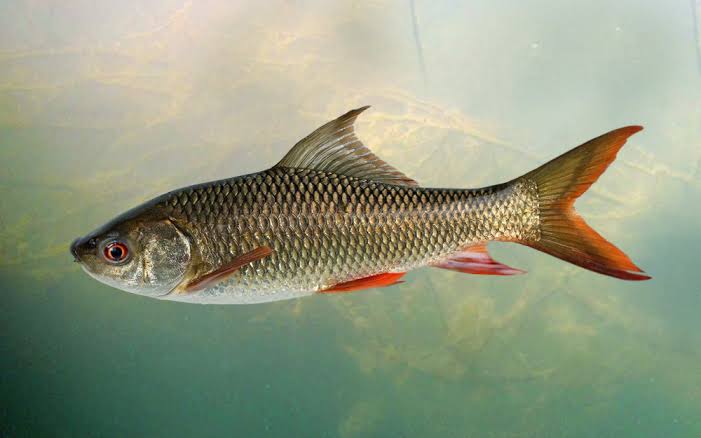
Disease prevention and control are critical aspects of maintaining a healthy and productive Rohu (Labeo rohita) fish farming operation. Implementing effective strategies to minimize the risk of diseases and promptly addressing any outbreaks are essential for the overall sustainability of the aquaculture venture.
One fundamental aspect of disease prevention is maintaining good water quality. Regular monitoring of parameters such as dissolved oxygen levels, pH, ammonia, and temperature is crucial. Proper water management, including regular water exchange and maintaining appropriate stocking densities, helps create an environment that reduces stress on the fish and minimizes the likelihood of disease.
Biosecurity measures play a pivotal role in preventing the introduction and spread of diseases in Rohu fish farms. Implementing strict entry protocols, including disinfection procedures for equipment and personnel, helps mitigate the risk of introducing pathogens to the farm. Quarantine facilities for new fish arrivals can further ensure that potential diseases are not introduced to the existing population.
Selecting disease-resistant Rohu strains is a proactive measure in disease prevention. Working with reputable hatcheries and choosing fish with known genetic resilience to common diseases in the region can significantly reduce the susceptibility of the fish population.
Regular health monitoring is essential for early detection of any signs of disease. Conducting routine visual inspections of fish behavior, appearance, and overall condition can help identify abnormalities. In case of any suspicion, prompt action, including isolating affected individuals and seeking professional advice, is crucial to prevent the spread of diseases within the farm.
Vaccination is an effective tool in disease control for Rohu fish farming. Utilizing vaccines tailored to common diseases in the region can provide an additional layer of protection. Collaborating with fish health professionals to design and implement a vaccination program specific to the farm’s needs can contribute to long-term disease management.
In the event of a disease outbreak, swift and targeted intervention is vital. Quarantining affected fish, implementing treatment protocols, and adjusting management practices to address the underlying causes of the outbreak are key steps. Collaboration with fish health experts and authorities can provide valuable guidance in formulating an effective response.
Education and training of farm personnel on disease prevention and control measures are essential components of a robust management strategy. Equipping staff with the knowledge and skills to identify, report, and address potential disease issues enhances the overall biosecurity of the farm.
However, disease prevention and control in Rohu fish farming require a comprehensive and proactive approach. From maintaining optimal water quality and implementing biosecurity measures to selecting disease-resistant strains and conducting regular health monitoring, a combination of strategies contributes to a resilient and healthy fish population.
Continuous vigilance, quick response to emerging issues, and ongoing education form the foundation for successful disease management in Rohu aquaculture.
Rohu Fish Breeding Techniques: Guide to Successful Reproduction
Successful reproduction of Rohu (Labeo rohita) in aquaculture involves a nuanced understanding of their breeding biology and the implementation of effective breeding techniques. Here is a comprehensive guide to facilitate successful Rohu fish breeding:
1. Understanding Reproductive Biology: Rohu exhibits indeterminate fecundity, meaning that females can produce multiple batches of eggs during the breeding season. The reproductive cycle is influenced by environmental factors, particularly temperature and photoperiod. Typically, Rohu spawns during the monsoon season when water temperatures are favorable.
2. Broodstock Management: Maintaining healthy broodstock is crucial for successful reproduction. Ensure that broodfish are of optimal age and size, with well-developed gonads. Providing a balanced and nutritious diet, along with proper environmental conditions, promotes gonadal development in both male and female broodstock.
3. Hormonal Manipulation: In aquaculture, hormonal manipulation is often employed to induce synchronized spawning. Using hormones such as pituitary extracts or synthetic analogs triggers the release of eggs and milt. This technique allows for controlled breeding, facilitating efficient egg collection and subsequent larval rearing.
4. Spawning Techniques: Rohu is a pelagic spawner, and natural breeding in ponds can be encouraged by creating conducive conditions. This includes maintaining appropriate water temperature, providing suitable spawning substrates, and ensuring adequate dissolved oxygen levels. In controlled environments, induced spawning involves injecting hormones into broodfish to stimulate gamete release.
5. Egg Collection and Incubation: Once spawning occurs, it is essential to promptly collect the eggs to prevent cannibalism by adult fish. Eggs are typically adhesive and adhere to substrates. Artificial spawning substrates or mesh trays are used for easy collection. The eggs are then incubated in specially designed hatchery units, providing optimal conditions for embryonic development.
6. Larval Rearing: Upon hatching, Rohu larvae are fragile and require careful attention. Larval rearing tanks with controlled environmental parameters are essential for their development. Providing appropriate larval feeds, such as live zooplankton or formulated diets, supports their growth and survival during the early stages.
7. Weaning and Pond Culture: As the fish grow, they are transitioned to larger ponds for further development. Weaning involves gradually introducing formulated feeds to replace live feeds. Pond culture involves managing stocking densities, water quality, and nutrition to ensure robust growth until the fish reach marketable size.
8. Monitoring and Disease Management: Regular monitoring of the breeding and rearing process is crucial for identifying potential issues. Implementing biosecurity measures minimizes the risk of diseases affecting both broodstock and offspring. Prompt intervention in case of any health concerns ensures the overall success of the breeding program.
9. Continuous Research and Improvement: Aquaculture practices evolve, and ongoing research plays a vital role in refining breeding techniques. Staying informed about advancements in fish breeding, genetics, and nutrition contributes to the continuous improvement of Rohu aquaculture.
In addition, successful Rohu fish breeding involves a combination of understanding reproductive biology, proper broodstock management, hormonal manipulation, spawning techniques, egg collection, larval rearing, weaning, pond culture, and vigilant monitoring. By integrating these elements, aquaculturists can enhance the efficiency and sustainability of Rohu reproduction in captivity.
Read Also: Ruminant Animals: A Comprehensive Guide
Harvesting and Processing Your Rohu Fish Farm Yield
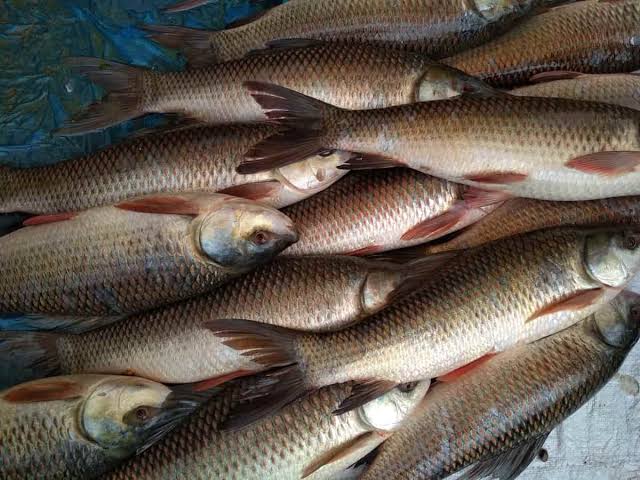
Harvesting and processing the yield from your Rohu (Labeo rohita) fish farm is a crucial phase that requires careful planning and execution. A well-managed harvest ensures the delivery of high-quality fish to the market while minimizing stress and maintaining product freshness.
Timing is a critical factor in the harvesting process. Determining the optimal harvest time depends on factors such as the target market size, growth rates of the fish, and prevailing market demand. Harvesting at the right size ensures that the fish meet consumer preferences and market standards.
Harvesting methods vary, and the choice depends on the scale of the operation and the infrastructure available. Common methods include seining, gill netting, and pond draining. Selecting the most suitable method minimizes stress on the fish and facilitates efficient collection.
Post-harvest handling is a crucial aspect of maintaining fish quality. Quick and gentle handling helps minimize stress and avoid injuries to the fish. Using appropriate equipment, such as aerated transport containers, ensures proper oxygenation during transportation from the pond to the processing facility.
Processing facilities should be equipped with the necessary tools and equipment for efficient fish processing. Depending on market demands, processing may include cleaning, gutting, filleting, and packaging. Proper hygiene practices during processing are essential to meet food safety standards and maintain product integrity.
Efficient cold chain management is critical to preserving the freshness and quality of the harvested Rohu. Rapid chilling or freezing helps prevent bacterial growth and deterioration of the fish. Cold storage facilities with controlled temperatures are essential for maintaining the desired quality until the fish reach the consumer.
Market considerations play a significant role in determining the form in which the harvested Rohu is presented to consumers. Whether whole, filleted, fresh, or frozen, understanding market preferences and trends is vital for successful product placement.
Compliance with food safety regulations and standards is non-negotiable in fish processing. Implementing Hazard Analysis and Critical Control Points (HACCP) and Good Manufacturing Practices (GMP) ensures the safety and quality of the processed Rohu. Regular inspections and quality control checks further contribute to meeting industry standards.
Establishing effective distribution channels is the final step in bringing the Rohu yield to consumers. Collaborating with retailers, markets, or processing facilities that align with your target market ensures a smooth transition from farm to table.
However, harvesting and processing the yield from your Rohu fish farm involve careful consideration of timing, handling, processing methods, cold chain management, market preferences, and adherence to food safety standards. By approaching these aspects systematically, aquaculturists can ensure the delivery of high-quality Rohu products to the market, contributing to the success and sustainability of their fish farming enterprise.
Market Strategies for Selling Your Rohu Fish Products
Successfully selling your Rohu (Labeo rohita) fish products in the market requires strategic planning and effective marketing approaches. Understanding market dynamics, consumer preferences, and building strong distribution channels are key elements in creating a successful market strategy.
Start by conducting thorough market research to identify consumer preferences, demand trends, and potential competitors. Knowing your target market allows you to tailor your products to meet consumer expectations, whether it’s in the form of whole fish, fillets, or value-added products.
Establishing a strong brand presence is crucial for differentiation in the market. Develop a compelling brand identity that communicates the quality, sustainability, and uniqueness of your Rohu products. Consider factors such as packaging design, labeling, and messaging to create a positive and memorable brand image.
Build relationships with key players in the distribution chain, including retailers, wholesalers, and processors. Collaborate with reputable partners who share your commitment to quality and sustainability. Strong partnerships contribute to effective market penetration and distribution.
Utilize various marketing channels to reach a broader audience. Online platforms, social media, and e-commerce can be powerful tools for promoting your Rohu products. Engage with consumers through informative content, recipes, and visual storytelling to create a connection between your brand and potential customers.
Participate in local markets, food festivals, and events to showcase your Rohu products directly to consumers. Offering samples, promotions, and engaging with potential customers in person can help create brand loyalty and generate word-of-mouth referrals.
Consider certifications or labels that highlight the quality and sustainability of your Rohu products. Eco-friendly and ethical practices are increasingly important to consumers, and certifications can build trust and credibility in the market.
Offering a diverse product range, including fresh and frozen options, can cater to different consumer preferences and market demands. Providing flexibility in packaging sizes and formats allows you to meet the needs of both individual consumers and larger retailers.
Stay informed about market trends and adapt your product offerings accordingly. Whether it’s responding to changing consumer preferences, introducing new flavors, or exploring innovative processing techniques, staying agile in your product strategy keeps your offerings relevant in the market.
Seek feedback from consumers and actively respond to reviews and comments. Positive customer experiences contribute to brand loyalty, while addressing concerns promptly demonstrates your commitment to customer satisfaction.
In addition, successful market strategies for selling your Rohu fish products involve a combination of understanding market dynamics, building a strong brand, establishing distribution channels, utilizing various marketing channels, participating in events, considering certifications, offering a diverse product range, staying informed about trends, and actively engaging with consumers.
By implementing these strategies, you can enhance the visibility and desirability of your Rohu products in the market.
Sustainability Practices in Rohu Fish Farming: A Green Approach
In adopting a green approach to Rohu (Labeo rohita) fish farming, sustainability practices play a pivotal role in minimizing environmental impact and promoting long-term ecological balance.
These practices encompass a holistic approach to aquaculture that prioritizes environmental responsibility, resource efficiency, and conservation. Some key sustainability practices include:
1. Pond Ecosystem Management: Implementing eco-friendly pond management practices, such as maintaining optimal water quality, promoting biodiversity, and avoiding the use of harmful chemicals, contributes to a healthier pond ecosystem.
2. Natural Feeds and Balanced Nutrition: Incorporating natural and organic feeds into the diet of Rohu reduces reliance on conventional feeds, which can have environmental consequences. Ensuring a balanced and nutritious diet supports fish health and minimizes nutrient discharge.
3. Efficient Water Use: Adopting water-efficient technologies, like recirculating aquaculture systems (RAS) or water reuse, helps minimize water consumption and waste. This not only conserves water resources but also reduces the environmental footprint of the fish farming operation.
4. Renewable Energy Sources: Utilizing renewable energy sources, such as solar or wind power, for energy needs in the fish farm aligns with green practices and reduces reliance on non-renewable energy.
5. Responsible Stocking Densities: Maintaining responsible stocking densities prevents overloading pond ecosystems, ensuring a balance between fish population and the available resources. This promotes fish health and overall environmental sustainability.
6. Polyculture and Integrated Farming: Introducing polyculture or integrated farming systems diversifies production, enhances resource utilization, and promotes synergies between different agricultural activities.
7. Water Conservation Measures: Implementing water conservation measures, including rainwater harvesting, helps reduce dependence on external water sources and enhances the overall water use efficiency of the fish farm.
8. Habitat Restoration: Engaging in habitat restoration efforts around the farm area supports biodiversity and ecosystem health. This includes preserving or replanting native vegetation and creating buffer zones.
9. Disease Prevention Strategies: Emphasizing disease prevention strategies, such as biosecurity measures and responsible antibiotic use, reduces the need for chemicals that may have adverse environmental impacts.
10. Certification and Standards: Participating in certification programs or adhering to sustainable aquaculture standards demonstrates a commitment to environmentally responsible practices and provides assurance to consumers.
11. Community Awareness and Education: Promoting community awareness and education on sustainable fishing practices and environmental conservation fosters a sense of shared responsibility for the local ecosystem.
12. Waste Management: Recycling and proper disposal of waste generated from the fish farming process prevent pollution and contribute to a more environmentally friendly operation.
13. Collaboration with Stakeholders: Collaborating with environmental agencies, local communities, and other stakeholders helps promote sustainability initiatives, address environmental concerns, and build a more resilient aquaculture ecosystem.
14. Innovation and Technology: Researching and implementing innovative technologies, such as water treatment innovations or efficient feed formulations, contribute to the continuous improvement of sustainability practices in Rohu fish farming.
Adopting these sustainability practices not only aligns with a green approach to fish farming but also ensures the long-term viability of Rohu aquaculture while minimizing its ecological footprint.
Common Issues and their Solutions in Rohu Fish Farming
In Rohu (Labeo rohita) fish farming, several common issues can arise, affecting fish health, growth, and overall farm productivity. Here are some of these issues and potential solutions:
1. Water Quality Problems:
Issue: Poor water quality can lead to stress and diseases in Rohu.
Solution: Regularly monitor water parameters such as dissolved oxygen, pH, ammonia, and temperature. Implement proper water management practices, including water exchange, aeration, and maintaining appropriate stocking densities.
2. Disease Outbreaks:
Issue: Disease outbreaks can significantly impact fish health and production.
Solution: Implement strict biosecurity measures, including quarantine for new fish, regular health monitoring, and vaccination when applicable. Promptly isolate and treat affected individuals to prevent the spread of diseases.
3. Overstocking:
Issue: Overstocking can lead to competition for resources, poor water quality, and stunted growth.
Solution: Adhere to recommended stocking densities based on pond size and water quality. Avoid overstocking to ensure adequate space and resources for each fish.
4. Feeding Issues:
Issue: Inconsistent or improper feeding practices can affect growth rates and nutritional health.
Solution: Develop a feeding strategy based on the nutritional requirements of Rohu at different life stages. Use high-quality feeds and adjust feeding rates based on water temperature and fish behavior.
5. Oxygen Depletion:
Issue: Low oxygen levels can lead to fish stress and mortality.
Solution: Ensure proper aeration systems are in place, especially during warmer months. Avoid overfeeding, as excess feed can contribute to oxygen depletion. Monitor oxygen levels regularly.
6. Algae Blooms:
Issue: Excessive algae growth can lead to oxygen depletion and water quality issues.
Solution: Implement proper nutrient management, control light exposure to ponds, and consider the use of eco-friendly algae control methods. Ensure proper pond circulation to minimize stagnant areas.
7. Cannibalism:
Issue: Larger fish preying on smaller individuals can lead to uneven growth.
Solution: Provide adequate hiding spaces or shelters for smaller fish. Implement size grading to separate fish of different sizes. Monitor fish behavior regularly.
8. Temperature Fluctuations:
Issue: Drastic temperature changes can stress fish and impact their metabolic processes.
Solution: Monitor seasonal temperature variations and adjust management practices accordingly. Consider using shade nets or other methods to regulate water temperature in extreme weather conditions.
9. Environmental Pollution:
Issue: Runoff or discharge of pollutants can negatively impact water quality and fish health.
Solution: Establish buffer zones around the farm, implement proper waste management practices, and avoid the use of harmful chemicals. Adhere to environmental regulations.
10. Market Challenges:
Issue: Market fluctuations, pricing pressures, or inadequate marketing strategies can impact the economic viability of the farm.
Solution: Diversify marketing channels, build strong relationships with retailers, and stay informed about market trends. Consider value addition or processing to enhance market appeal.
Addressing these common issues in Rohu fish farming requires a proactive and systematic approach, involving regular monitoring, proper management practices, and a commitment to environmental and fish health considerations.
Read Also: The Impact of Waste to Art Business

